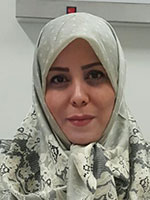Speakers

Dr. Farzaneh TORKAN
Chair, Physical Medicine and Rehabilitation Department, Milad Subspecialty Hospital, Tehran, Iran
Field of Study: Physical & Rehabilitation Medicine
Work Experience:
- Executive director of “Iranian Cardiovasculopulmunary rehabilitation Society”
- Chair of Medical committee of Iranian National Olympic committee
- Chair of department of “Physical Medicine and Rehabilitation of Milad subspecialty hospital”
- Chair of Department of “Physical Medicine and Rehabilitation of Khatam Ol Anbia, Hospital – Shefa Neuroscience research center”
- Chair of “Education and research of National Iranian Oil Company subspecialty hospital
Professional Organizations / Memberships:
- Iranian Medical Council - 1996 till now
- Iranian Society of Physical Medicine and Rehabilitation - 1999 till now
- International Society of Physical and Rehabilitation Medicine - 2002 till now
- Iranian council of Spinal cord injury - 2009 till now
- Member board of AOPRM (Asian Ocean physical and rehabilitation medicine society)
- Iranian committee of Cardio vascular pulmonary rehabilitation - 2012 till now
- Osteoporosis committee of Iranian Health Ministry - 2006 till now
- ISPRM Education Committee - 2007 till now
- Advisory Committee of 2010 ISPRM congress
- Advisory Committee of 2011,2012,2013, 2014 AOPRM congress
- Advisory Committee of 2013,2014 ISPRM
- Advisory Committee of “International Rehab Tech congress 2013”
Abstract
Cardiovascular, Pulmonary and Neuromuscular Involvement in COVID-19 and its Management
Regarding the most critical health threat in 21st century, caused by the coronavirus, identifying its controlling methods and treatments is the first priority of the medical society. Up-to-date methods are required for identifying and controlling coronavirus, due to its raising pervalence and mutations.
In this presentation, we discuss cardiac, pulmonary, and musculoskeletal side effects of coronavirus.
While COVID-19 may affect multiple organ systems, symptoms are most often located in the respiratory tract. Approximately 80% of symptomatic patients present with mild disease: symptoms of fever, runny nose, sore throat or dry cough. Moderate to severe disease is characterized by pneumonia.
Underlying CVD and/or development of acute cardiac injury are associated with significantly worse outcome in these patient, Information about other cardiovascular manifestations is very limited at patients with coronavirus disease 2019 (COVID-19) have underlying cardiovascular (CV) disease or develop acute cardiac injury during the course of the illness. Adequate understanding of the interplay between COVID-19 and CV disease is required for optimum management of these patients.
COVID-19 is primarily a respiratory illness but cardiovascular involvement can occur through several mechanism
Acute cardiac injury is the most reported cardiovascular abnormality in COVID-19, with average incidence 8-12%.
Recently research about musculoskeletal disorders in Covid 19 represent, COVID-19 that has an affinity for neural tissue. There are reports of encephalitis, encephalopathy, cranial neuropathy, Guillain-Barrè syndrome, and myositis/rhabdomyolysis in patients with COVID-19.
Moreover, Rehabilitation methods, especially exercise therapy, are discussed as supporting treatments for COVID-19. Considering cardiac side effects, like Myocarditis, and other pulmonary side effects, especially pneumonia, as well as identifying musculoskeletal side effects of COVID-19, including Neuropathy, have great importance. Furthermore, secondary side effects, caused by this disease due to deconditioning; results in a decrease in cardiac, respirational, and mobility performance of the patients after an acute period; however, by using an exact, scientific rehabilitation program, the recovery process can become shorter, and the patients can return to their normal lives cycles in a quicker way.
